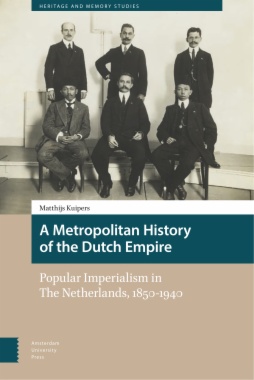A Metropolitan History of the Dutch Empire: Popular Imperialism in The Netherlands, 1850-1940 examines popular imperial culture in the Netherlands around the turn of the twentieth century. In various and sometimes unexpected places in civil society the empire played a prominent role and was key in mobilizing people for causes that were directly and indirectly related to the Dutch overseas colonies. At the same time, however, the empire was ostensibly absent from people's minds. Except for some jingoist outbursts during the Aceh War and the Boer War, indifference was the main attitude with which imperial affairs were greeted. How could the empire simultaneously be present and absent in metropolitan life? Drawing upon the works of scholars from fields ranging from postcolonial studies to Habsburg imperialism, the author argues that indifference to empire was not an anomaly to the idea of an all-permeating imperial culture, but rather the logical consequence of an imperial ideology that rendered metropole and colony firmly separated entities. The different groups and individuals that advocated imperial or anti-imperial causes – such as missionaries, former colonials, Indonesian students, and boy scouts – hardly ever related to each other explicitly and had their own distinctive modes of expression, but were nonetheless part of what the author calls a 'fragmented empire' and shared the common thread of Dutch imperial ideology. This suggests we should not mistake colonial culture's metropolitan invisibility for a lack of strength.
- Cover
- Table of Contents
- List of Abbreviations
- On Names and Terminology
- Introduction
- The Still Waters of Empire Run Deep
- Dutch Indifference
- The Metropole in the Colonial World
- Conquering the Metropolitan Mind
- The Politics of History
- Case Studies from a Fragmented Empire
- 1. Food and Indifference
- A Cultural History of the Rijsttafel in the Netherlands
- Dichotomies of a Colonial Dish
- The Metropolitan Rijsttafel
- Who’s Cooking?
- The Politics of Colonial Food
- The Limits of Permeation (Conclusion)
- 2. Indonesians and Cultural Citizenship
- The Metropolitan Microcosm of Empire
- Dissent and Cultural Citizenship
- Wim Tehupeiory: Naturalization and Social Mobility
- Tjipto Mangoenkoesoemo: Political Dissent in the Metropole
- Jodjana: The Arts and the Idea of Association
- Imperial Citizenship and Double Consciousness (Conclusion)
- 3. Schools and Propaganda
- History Books and Schools as Sites of Imperial Campaigns
- Schools, Teachers and Pupils
- History Lessons
- ‘Classroom Collections’
- Maps on the Wall (Conclusion)
- 4. Scouting and the Racialized Other
- Imperial Tropes in the Dutch Scouting Movement
- The Advent of Dutch Scouting
- An Empire without Boys
- Imperial Imagery in Dutch Scouting
- The 1937 Jamboree
- Scouting and Dutch Imperialism (Conclusion)
- 5. Missionary Organizations and the Metropolitan Public
- The ‘Inner Mission’ and the Invention of Mission Festivals
- Internal Colonialism
- Mission Festivals
- The Choice of a Missionary Career
- Gendered Role Models
- Finding Funds (Conclusion)
- Conclusion
- Sources
- Archives and Libraries
- Published Primary Sources
- Published Secondary Sources
- Index
- List of Figures and Tables
- Figures
- Figure 1 A modern-day Javanese tumpeng. According to the description, during the 1929 selamatan in the Van Geemert restaurant in The Hague a similar dish was served.
- Figure 2 Portrait of Mrs. Catenius-van der Meijden, author of Ons Huis in Indië (Semarang: Masman & Stroink, 1908)
- Figure 3 A rijsttafel in a colonial domestic setting. Original caption: ‘Familie Meyer aan de rijsttafel tijdens een kerstvakantie te Lawang bij Malang.’
- Figure 4 Drawing of Oost en West’s coat of arms by Menno van Meeteren Brouwer
- Figure 5 Boeatan’s tearoom. Original caption: ‘Boeatan’s tearoom, Heulstraat 19, Den Haag. Tea with Indies cake from 3 to 6 pm. All days except Sunday.’
- Figure 6 Portrait of the Indiërs Comité. From left, first row: Tjipto Mangoenkoesoemo, E.F.E. Douwes Dekker, Soewardi Soerjaningrat; second row: Frans Berding, G.L. Topée, and J. Vermaesen.
- Figure 7 Jodjana performing in Germany
- Figure 8 Poster announcing the 1937 World Scout Jamboree in Vogelenzang, Netherlands
- Tables
- Table 1 Annual number of classroom collections sent out by the Koloniaal Museum and the reported number requested by schools
- Table 2 Number of annual visitors to the Koloniaal Museum
- Table 3 Annual balance of the Nederlandsch Zendelinggenootschap in the 1880s

